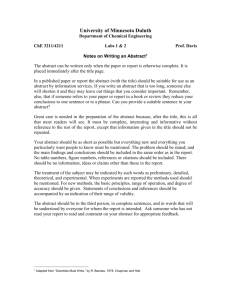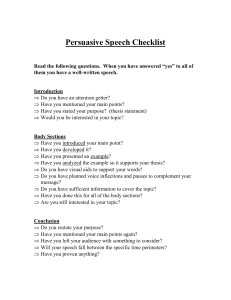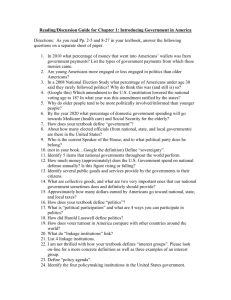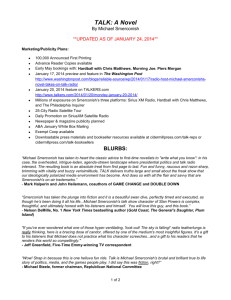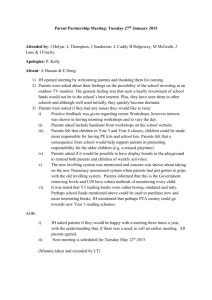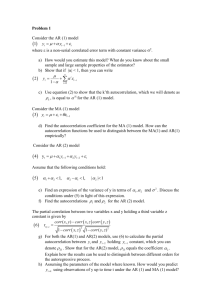Document 10465627
advertisement
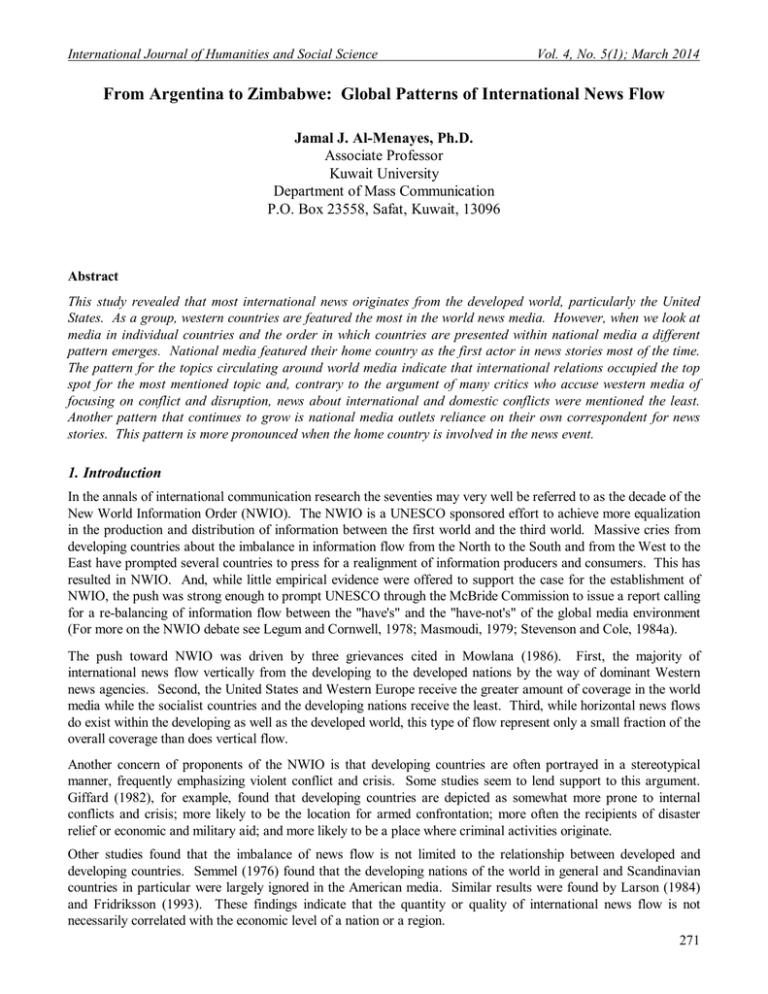
International Journal of Humanities and Social Science Vol. 4, No. 5(1); March 2014 From Argentina to Zimbabwe: Global Patterns of International News Flow Jamal J. Al-Menayes, Ph.D. Associate Professor Kuwait University Department of Mass Communication P.O. Box 23558, Safat, Kuwait, 13096 Abstract This study revealed that most international news originates from the developed world, particularly the United States. As a group, western countries are featured the most in the world news media. However, when we look at media in individual countries and the order in which countries are presented within national media a different pattern emerges. National media featured their home country as the first actor in news stories most of the time. The pattern for the topics circulating around world media indicate that international relations occupied the top spot for the most mentioned topic and, contrary to the argument of many critics who accuse western media of focusing on conflict and disruption, news about international and domestic conflicts were mentioned the least. Another pattern that continues to grow is national media outlets reliance on their own correspondent for news stories. This pattern is more pronounced when the home country is involved in the news event. 1. Introduction In the annals of international communication research the seventies may very well be referred to as the decade of the New World Information Order (NWIO). The NWIO is a UNESCO sponsored effort to achieve more equalization in the production and distribution of information between the first world and the third world. Massive cries from developing countries about the imbalance in information flow from the North to the South and from the West to the East have prompted several countries to press for a realignment of information producers and consumers. This has resulted in NWIO. And, while little empirical evidence were offered to support the case for the establishment of NWIO, the push was strong enough to prompt UNESCO through the McBride Commission to issue a report calling for a re-balancing of information flow between the "have's" and the "have-not's" of the global media environment (For more on the NWIO debate see Legum and Cornwell, 1978; Masmoudi, 1979; Stevenson and Cole, 1984a). The push toward NWIO was driven by three grievances cited in Mowlana (1986). First, the majority of international news flow vertically from the developing to the developed nations by the way of dominant Western news agencies. Second, the United States and Western Europe receive the greater amount of coverage in the world media while the socialist countries and the developing nations receive the least. Third, while horizontal news flows do exist within the developing as well as the developed world, this type of flow represent only a small fraction of the overall coverage than does vertical flow. Another concern of proponents of the NWIO is that developing countries are often portrayed in a stereotypical manner, frequently emphasizing violent conflict and crisis. Some studies seem to lend support to this argument. Giffard (1982), for example, found that developing countries are depicted as somewhat more prone to internal conflicts and crisis; more likely to be the location for armed confrontation; more often the recipients of disaster relief or economic and military aid; and more likely to be a place where criminal activities originate. Other studies found that the imbalance of news flow is not limited to the relationship between developed and developing countries. Semmel (1976) found that the developing nations of the world in general and Scandinavian countries in particular were largely ignored in the American media. Similar results were found by Larson (1984) and Fridriksson (1993). These findings indicate that the quantity or quality of international news flow is not necessarily correlated with the economic level of a nation or a region. 271 © Center for Promoting Ideas, USA www.ijhssnet.com Several studies were conducted to examine factors that influence the flow of news globally. Galtung (1971) proposed that there is a "center-periphery" pattern in the flow of international news. He hypothesized that news flow primarily from the "center," or dominant countries, to the "periphery," or dependent regions. This hypothesis was supported by a study by Kariel and Rosenvall (1984) that found that the "eliteness" of a country as a news source was the most important criterion for news selection. A country's "proximity" is another factor forwarded as a likely explanation for uneven coverage. Rosengren (1970) suggests a correlation between reader interest and the physical distance between countries. Galtung and Ruge (1965) postulated that the distance should be conceptualized in terms of cultural distance or proximity. Other studies that support the elitism and proximity concepts include Adams (1964), Ostgaard (1965), Hester (1971), Zaharopoulos (1990) and Cohen (1995). 2. Research goals This study seeks to examine patterns of international news flow by looking at the data generated from the forty countries participating in the May phase of the news flow project. Hence, this study is atheoretical and descriptive in nature. It defines a number of variables that collectively were included to draw a broad picture of the manifest content of news and the structure of international news reporting. The main concern of this study is with the following variables: where the news occurred (dateline), where the news item originated (source), what countries are in the news, what the news was about (topic). In addition, I attempt to venture slightly beyond the descriptive by looking at whether or not the choice of news source is affected by a country's involvement in the particular news event. Broadly, the aim of the current paper is to examine the May news flow data guided by these general questions: 2.1- What countries are featured in the news in the various regions of the world? 2.2- What is the main source of news for national media outlets around the world? 2.3- What national datelines are mentioned the most in news stories featured in the world media? 2.4- What kinds of topics are covered in stories featured in the world news media? 3. Method This study relies on data generated by a worldwide cooperative news flow project which includes more than forty countries. The project is similar to all-inclusive descriptive analysis of news content done 17 earlier (Stevenson and Shaw, 1984). Researchers from 40 countries covering all areas of the globe coded news stories from their respective countries on May 8 and 9 1995. The dates were chosen to coincide with the anniversary of the end of World War II in Europe. The specific media for each country include: 3.1. The most influential daily newspaper: This would be a serious daily published in the capital, widely read by government officials and other elites, and frequently quoted abroad. It may reflect or oppose government policies or report independently. In the United States, for example, this would be the New York Times or the Washington Post; in Britain, the newspaper could be the Times, Guardian, or the Independent. 3.2. A second leading newspaper: This category includes popular newspaper with high circulation, an important regional paper, or special interest paper. In our previous example this would be the Financial Times, Wall Street Journal, USA today, or Los Angeles Times. Large-circulation tabloids were excluded in most cases because they carry little international news and have little influence. 3.3. The leading daily newscast: This category reflects the early-evening or prime time national TV news cast with the largest audience. In a few countries this is a radio newscast. In Britain, for example, this includes the BBC or Channel 4 early evening news or ITN news at Ten; in the United States, this would be one of the three commercial TV network early evening newscasts. 3.4. A second complimentary newscast: This category was included as applicable to certain countries. For example, some countries have newscasts that are broadcast in a second language for the benefit of segments of the population that don't speak the national tongue The research design was largely descriptive rather than focused on specific and complex issues. And despite its size it was, on the whole, a rather simple project both conceptually and methodologically. 272 International Journal of Humanities and Social Science Vol. 4, No. 5(1); March 2014 The design was necessary because of the sheer size of the participating teams and because many of the teams lacked the resources to carry out a more complex design. In addition, a simple design was deemed appropriate because a reasonably comprehensive global inventory of foreign news content characteristics, while significant to the current international debate, is missing. This macro-level study of foreign news is a necessary foundation upon which more complex and more narrowly focused studies can be built. In addition to the specific media mentioned above, variables used in this study include the following: (a) National dateline: The dateline is the name of the city from which the news story is reported. If a story has no dateline because it was written locally, it was assigned the value "not applicable/none." (b) First country in the news and second country in the news. As mentioned above, a dateline has a specific geographic reference. However, sometime stories are written about groups of countries, regions, or without specific geographic reference. Another problem is that stories sometimes focus equally on more than one country. If two or more countries are represented about equally, coders were instructed to look at the headline and dateline to see which should be considered most important country. If that wasn't possible, the first country mentioned in the story was coded as the most important and those listed second were assigned the appropriate value. (c) First news source. This variable identifies the source to which the story is clearly attributed including national and international news agencies, exchanges and media outlet own correspondent. More than 40 categories were allowed for source identification. Categories were grouped to identify different source: 00-09 are general categories plus national news agencies; codes 10-19 reflect the major global agencies; and so on. (d) Main topic. The categories for this variable are descriptive in nature. They address the main thrust of the story and attempt to distinguish between politics and economics. Coders were instructed to choose among 22 possible categories to code up to three distinct topics. The categories include international politics, international economics, military, sports, human rights and others. The main topic is the first among the three possible topics. (e) Country's involvement in the news. This is a recoded variable. The original variable "focus of story" acknowledges that foreign news can take place at home. It includes two elements -- geographic location of the event and involvement (or lack of it) of the home country. All stories that take place overseas and those at home with a substantial international element were included. This resulted in four distinct categories: 1. Foreign dateline; no involvement of own country. 2. Foreign dateline; significant involvement of own country. 3. Domestic dateline; no involvement of own country. 4. Domestic dateline; significant involvement of own country. A recoded "dummy variable" was created with categories 1 and 3 coded as 0 (not involved) and categories 2 and 4 coded as 1 (involved). (f) Event disruptiveness. This variable distinguishes between stories that emphasize disruption, conflict, and exceptional events and stories that do not. The code 1 is used for stories that focus on war, natural disasters, accidents, demonstrations and protests (even when peaceful and legal), crime, violence, and similar kinds of activities and behavior. The code 2 was used for other types of events. 273 © Center for Promoting Ideas, USA www.ijhssnet.com The following pages include the results of a fairly limited analysis of the data from the 40 countries who participated in the May phase of the news flow project. All 40 countries were included in the aggregate analysis. However, where individual countries are mentioned, the author relied on a sample of about 20 countries representing the various regions of the world. To include all countries in an exploratory paper of this sort would probably produce so many numbers that any sense of their meaning would be lost. The purpose of this study is to examine in general terms what the data tell us about the current landscape of international news flow and not provide a test of specific hypotheses. 4. Results 4.1 Where news originate in the world Table 1 shows percentages from aggregate data representing national datelines of news stories in rank order. With an 11.4% share, the United States is ranked first in terms of being an origin of news, followed by the United Kingdom (5.6) and Russia (4.4). This means that based on this sample a little over one tenth of the world news are filed from the United States regardless of the story's content. That is slightly more than news originating from Japan, China and South Korea combined (3.3, 3.1, and 3.1 respectively). And, while there is no clear East-West direction of flow, the pattern seems to be one of more news coming out of the industrialized nations of the world than from developing countries (Egypt is the only developing country with a score of over 2%). Table 1: Where news comes from: National dateline of news stories in rank order ______________________________________________________________________ Country Percent (n) Rank USA 11.4 (849) 1 UK 5.6 (421) 2 Russia 4.4 (329) 3 Japan 3.3 (248) 4 China 3.1 (232) 5 S. Korea 3.1 (235) 6 Egypt 2.4 (179) 7 Spain 2.2 (168) 8 Italy 1.9 (145) 9 Ukraine 1.6 (118) 10 Hungary 1.4 (104) 11 Lebanon 1.3 (100) 12 Iceland 1.2 (90) 13 Sweden 1.0 (78) 14 Bosnia 1.0 (77) 15 N/A 15.0 (1110) -_____________________________________________________________________ Datelines mentioned less than 1% not included 4.2 Countries featured most in the news and sources relied on the most As a group Western countries are featured in world news media the most. As table 2 indicates that the United States is the country mentioned the most (13%) followed by France (8%) and the United Kingdom (5.9). A similar pattern exists in the second country mentioned in the news. However, when we look at individual countries media a different pattern emerges. Table (3) shows the same variables for a sample of countries from all regions of the world. With just a couple of exceptions (Israel and Kuwait) all countries mentioned themselves as the first and second actor in foreign news stories. The exceptions though are quite interesting. They all come from smaller countries that are heavily dependent on a larger country for national security and/or economic viability. Both Israel and Kuwait mentioned the United States as the first actor in their news media (16%, and 13% respectively), while Hong Kong referred most frequently to China as the first actor in its foreign news stories (35%). This pattern seems consistent with the "center-periphery" hypothesis. 274 International Journal of Humanities and Social Science Vol. 4, No. 5(1); March 2014 Table 2 : Countries featured in the news in rank order (aggregate data) Country Percent (n) USA France UK Russia Germany China Japan S. Korea Italy 13% (973) 8 (596) 6 (442) 5.2 (390) 5.1 (380) 4 (296) 3.5 (258) 3 (225) 2 (147) Rank 1 2 3 4 5 6 7 8 9 Countries mentioned less than 2% not included. Table 3: Countries featured in the news and main news source First country in news Second country in news Region First news source North America USA USA (18%) USA (33%) Own corr (70%) South America Argentina Cuba Venezuela Argentina (21) USA (17) USA (27) USA (16) Cuba (26) ----- Own corr. (20) Agencies (35) ------ Germany (31) U.K. (78) Spain (20) Germany (11) ----------- Agencies (34) Own corr. (91) Own corr (56) Hungary (24) Slovania (13) Hungary (11) ---- Own corr (38) Own corr (25) Ukraine (50) ----- Kenya (22) Nigeria (30) ----Nigeria (13) Own corr. (34) Own corr. (26) USA (16) USA (13) -------- Israel (18) ----------- Own corr (59) Own corr (18) Own corr (41) China (43) India & USA (13) ------India (13) Own corr (47) Own corr (30) Japan (26) S. Korea (23) China (35) H.K < 1% USA (14) USA (11) ----- Own corr. (82) Own corr. (28) Own corr. (23) W. Europe Germany U.K. Spain E. Europe Hungary Slovania Former USSR Ukraine Sub S. Africa Kenya Nigeria Middle East Israel Kuwait Lebanon Asia China India Pacific Rim Japan S. Korea Hong Kong ---- Empty cells mean that no single country was mentioned more than 10%. 275 © Center for Promoting Ideas, USA www.ijhssnet.com Another pattern evident in table 3 is that most national media relied on their own correspondent for international news stories. The level of reliance ranged from 18% (Kuwait) to 91% (United Kingdom). This pattern holds regardless of a country's location or level of economic development. From this sample only Germany and Cuba relied more on other sources for international news. A similar but weaker pattern occurred in the 1979 data (Stevenson and Cole, 1984b) where it was shown that in most countries, even the smallest and poorest, between 10 percent and 40 percent of all foreign news is credited to the media's own correspondents. While there is no question about the role of Western news agencies in providing news to the world's regional and national media, the relationship is far from being one of "dependence" as characterized by many critics. 4.3 Topics featured in the world media A familiar theme in international news flow is the overemphasis on "bad" news typically reflecting social disruption and natural disasters. Table 4 addresses the main topics featured in world media. Just over fourteen percent of world news is concerned with international politics. This is followed by sports (13.4%) and domestic politics (12.6). News about "international conflict" occupy a distant fifth position just below "art and culture" while news about "domestic conflict" come in at last place mentioned only 4.5% of the time. Table 5 shows topic distribution broken down by country. It is clear that across all nations, regions, political and economic systems, one pattern emerges: news is politics. Between one quarter and one-half of all foreign news in all of the countries dealt with domestic politics or with international relations. Other notable clusters of topics include sports, international economics, culture and conflict, both domestic and international. Beyond these categories, there is no single class of main topic averaging close to 10 percent in any country. Table ( 4): General topics in the world media in rank order __________________________________________________ Main Topic n Percent Rank International Politics 1075 14.4% 1 Sports 998 13.4 2 Domestic Politics 940 12.6 3 Art & Culture 707 9.5 4 International Economics 672 9.0 5 International Conflict 671 9.0 5 Crime/Justice/Police 407 5.4 6 Civil War 337 4.5 7 Entertainment/People 278 3.7 8 __________________________________________________ Topics mentioned less than 3% not included 276 International Journal of Humanities and Social Science Vol. 4, No. 5(1); March 2014 Table 5: Distribution of Main Topic Int. Politics Int. Econ Int. Conflict Domestic Pol. Dom.Conf. Culture Sports ________________________________________________________________________ Country North America USA 8% 9% 21% 17% 10% 15% 3% South America Argentina Cuba Venezuela 5 28 12 8 1 11 3 2 4 14 8 14 5 8 2 14 21 6 W. Europe Germany U.K. Spain 8 11 10 8 -7 4 14 2 11 -21 5 --- 21 5 5 7 -14 E. Europe Hungary Slovenia 10 7 12 4 9 3 12 14 3 13 8 7 22 26 Former USSR Ukraine 13 3 13 5 3 27 5 Sub S. Africa Kenya Nigeria 3 6 4 11 8 8 19 11 10 4 7 4 -14 Middle East Israel Kuwait Lebanon 18 32 16 8 30 5 9 17 10 11 2 12 4 -4 18 7 7 15 -15 Asia China 17 14 25 8 -- -- 22 India 25 8 3 7 9 6 25 16 -18 Pacific Rim Japan 40 16 1 16 1 2 9 S. Korea 11 14 11 14 1 6 16 Hong Kong 15 8 4 12 4 2 11 ________________________________________________________________________________________ Empty cells mean the topic was mentioned less than 1% The pattern just noted holds both across media of all of the countries, and within each country regardless of region, political system, or socio-economic conditions. One would caution though that the data say nothing about the nature of coverage within each of these categories. As alluded to earlier, coding procedures were kept simple in order to accommodate the large number and variety of participating countries in a project of this magnitude. 277 © Center for Promoting Ideas, USA www.ijhssnet.com 4.4 The impact of home country involvement in foreign stories In light of the aforementioned pattern of more national media relying on their own correspondent for foreign news, it seemed reasonable to wonder what conditions might promote such a trend. One likely answer is that events abroad are having more impact on conditions at home, and the more impact an international event is likely to have on domestic conditions the more national media would want to have a first hand account of that event. Table (6) addresses the issue of country involvement and its impact on choice of news source. It is obvious that national media rely heavily on their own correspondent when their home country is involved in the news event. Sixty six percent of stories were written by their own correspondent when the country is involved in the news event compared to 37% when the country is not involved. This patterns holds for print as well as broadcast media with the latter, as a group, making more use of their own correspondent than the former. Table 6: Percent of news stories written by own correspondent based on a country’s Involvement in the story ______________________________________________ All media Print Broadcast ______________________________________________ Involved not involved 66% * 37 64%* 35 70%* 50 n 7474 6004 1454 ______________________________________________ *X2 significant, p<.001 for the involvement factor. National media reliance on their own correspondent as a news source was explored further by looking at the nature of the news event. Events were classified as either disruptive or non-disruptive (Table 7). Disruptive news include stories that focus on war, natural disasters, accidents, demonstrations and protests, while non-disruptive news include all other types of stories. When the event was disruptive the news media relied more on sources other than their own correspondent (66%) like news agencies and global news services. However, when the event was nondisruptive national media relied as much on their own correspondent as they did on other sources. This may be due to the nature of disruptive news that are largely unpredictable making it both difficult and costly for national media to dispatch their own correspondent to cover the event. Table 7: Percent of news stories written by own correspondent based on event disruptiveness _________________________________________________________ Own Correspondent Other Sources _________________________________________________________ Disruptive event 33% 66% (n=1369) Non-disruptive event 47 52 (n=3655) _________________________________________________________ X2 = 75, p<.001 5. Conclusion This study of global news flow revealed that many of the patterns discovered in the seventies and eighties still persist in the nineties. Most international news originate from the developed world, particularly the United States. As a group, western countries are featured the most in the world news media. However, when we look at media in individual countries and the order in which countries are presented within national media a different pattern emerges. National media featured their home country as the first actor in news stories most of the time. 278 International Journal of Humanities and Social Science Vol. 4, No. 5(1); March 2014 The pattern for the topics circulating around world media is no different from the past either; news is politics and politics is news. International relations occupied the top spot for the most mentioned topic and, contrary to the argument of many critics who accuse western media of focusing on conflict and disruption, news about international and domestic conflicts were mentioned the least. In fact, politics occupy about one forth of world news and if we combine politics with economics that would cover over a third of world news. Another pattern that continues to grow is national media outlets reliance on their own correspondent for news stories. This pattern is more pronounced when the home country is involved in the news event. This suggests that developing countries are not entirely dependent on western news agencies for information particularly when they are involved in the unfolding story. References Adams, J.B. (1964). A qualitative analysis of domestic and foreign news on the APTA Wire, Gazette, 10 (2): 28595. Cohen, Y. (1995). Foreign press corps as an indicator of international news interest, Gazette, 56 (1): 89-100. Fridriksson, L. (1993). Coverage of Scandanavia in the U.S. news media. Paper presented at the Association for Education in Journalism and Mass Communication annual conference. Kansas City, Mo. August 1993. Galtung, J. (1971). A structural theory of imperialism. Journal of Peace Research, 8 (2): 81-117. Galtung, J. and M.H. Ruge (1965). The structure of foreign news: The presentation of the Congo, Cuba and Cyprus in four foreign newspapers, Journal of International Peace Research, 1 (1): 65-91. Hester, A. (1971). An analysis of news flow from developed and developing nations. Gazette, 7 (3): 29-43. Kariel, H.G. and L.A. Rosenvall (1984). Factors influencing international news flow. Journalism Quarterly, 61 (3): 509-516. Larson, J. F. (1984). Television's Window on the World: International Affairs Coverage on the U.S. Networks. Norwood, N.J.: Ablex Publishing Co. Legum, C. and J. Cornwell (1978). A Free and Balanced Flow. Lexington, Mass.: Lexington Books. Masmoudi, M. (1979). The new world information order. Journal of Communication, 29 (2): 172-85. Ostgaard, E. (1965). Factors influencing the flow of news, Journal of International Peace Research, 6 (2): 39-63. Rosengren, K.E. (1970). International news: time and type of report, in J.C. Merrill and H.D. Fischer (eds.) International Communication: Media , Channels, Functions. New York: Hastings House, pp. 74-80. Semmel, A. K. (1976). Foreign news in four U.S. elite dailies: some comparisons, Journalism Quarterly, 53 (4): 732-736. Stevenson, R.L. and R. Cole (1984)a. Issues in foreign news. In R.L. Stevenson and D.L. Shaw (eds.), Foreign News and the News World Information Order. Ames, Iowa: Iowa State University Press, pp. 5-20. Stevenson, R.L. and R. Cole (1984)b. Patterns of foreign news. In R.L. Stevenson and D.L. Shaw (eds.), Foreign News and the New World Information Order. Ames, Iowa: Iowa State University Press, pp. 37-62. Zaharopoulos, T. (1990). Cultural proximity in international news coverage: 1988 US presidential election in the Greek press, Journalism Quarterly, 67 (1): 190-94. Stevenson, R.L. and D. L. Shaw (eds.) (1984). Foreign News and the New World Information Order. Ames, Iowa: Iowa State University Press. 279

